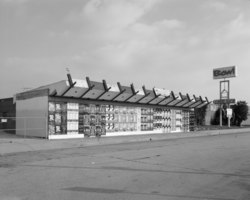| Holiday Bowl | |
|---|---|
 Holiday Bowl in 2002 | |
 | |
| General information | |
| Architectural style | Googie |
| Address | 3730 Crenshaw Blvd. |
| Town or city | Los Angeles, California |
| Country | United States |
| Coordinates | 34°01′09″N 118°20′05″W / 34.0191°N 118.3346°W |
| Current tenants | Starbucks, Walgreens |
| Construction started | 1958 |
| Technical details | |
| Floor count | 1 |
| Design and construction | |
| Architect(s) | Helen Liu Fong |
| Architecture firm | Armet & Davis |
The Holiday Bowl was a bowling alley on Crenshaw Boulevard in Los Angeles, California. It was founded in 1958 by five Japanese-Americans and was a significant part of the rebuilding process of the Nikkei community after internment during World War II.[1] The owners of the Holiday Bowl sold shares throughout the community to finance its construction."[1]
YouTube Encyclopedic
-
1/3Views:5715691 291
-
The Holiday Bowl History Project
-
CSTV Holiday Special
-
Thomas Jefferson Holiday Bowl 2007
Transcription
Cultural significance
Located on Crenshaw Boulevard, the Holiday Bowl was important in the desegregation of Los Angeles and served an Anglo American, African American, and Japanese American clientele.[1] The coffee shop served grits, udon, chow mein, and hamburgers.[1] The Bowl operated four decades, and was a cultural, architectural, and recreational feature for the Crenshaw business district "as the Hollywood Bowl has for the Hollywood Hills".[2]
History
The Bowl was built by Japanese entrepreneurs as a combination bowling alley, pool hall, bar and coffee shop in 1958 and served Crenshaw's Japanese residents who "had not long before suffered Manzanar's internment camps and a blanket racial ban by the American Bowling Congress."[2] A Los Angeles Times magazine story noted: "Once haunted at 4 a.m. by swing-shift aerospace workers and nighthawk Central Avenue jazz musicians, the Holiday Bowl, like Leimert Park to its south, remains a concrete expression of community in an era when the whole notion of community has been raised to the level of abstraction."[2] A 1999 LA Weekly story said, "Holiday speaks of Crenshaw’s bright, enduring middle-class dreams, with its ’50s-inspired orange-and-green décor and giant plate-glass window that affords a grand view of Baldwin Hills to the south. Eat your grits and eat your heart out."[3] The article also states that the ownership of the Bowl changed hands several times and offered "a huge cross section of ethnic dishes: Japanese (harusame (春雨), yakisoba, donburi), Chinese (a vast assortment of chow mein, pork noodles, Foo young, saifun) and black Southern (hot links, grits, salmon patties, short ribs, biscuits and gravy)."[3]
The owner said he took pride in Holiday's staying power, in its history, and the fact that it was designed by Armet & Davis, "the architectural firm that popularized Googie-style coffee shops and turned diners like Holiday and the nearby Wich Stand into zig-zaggy emblems of L.A. optimism."[3] He said the building was not damaged during the 1992 Los Angeles riots and that people bowled that night.[3]
Architecture
The Holiday Bowl is considered an example of Googie architecture and was designed by the Armet & Davis architectural firm.[4] The firm is said to have "defined '50s Googie architecture".[2] Helen Liu Fong was the designer at Armet & Davis who is credited with designing the Holiday Bowl.[5]
The Bowl was photographed in stereo for 3-D viewing by Jack Laxer.[6]
Closure
The Bowl closed in 2000 and was targeted for demolition. Bowl supporters mobilized, persuading the City of Los Angeles's Cultural Heritage Commission to designate the structure an historical-cultural monument.[1] It is listed as number 688 on the City of Los Angeles Historic Cultural Monument list.[4][7]
Revitalization
The former bowling alley front area was refurbished in October 2004 and replaced with a modern outdoor shopping center anchored by Walgreens that opened in early 2006. The former Coffee Shop had become a Starbucks Coffee and other restaurants from the former alley and the neon signs from the nearby former famous Honda/Pontiac car dealership had been upgraded.[8][9] Preservationists wanted the landmark saved for its history, cultural significance, and architectural history.[10]
References
- ^ a b c d e Holiday bowl History project The Studio for Southern California History https://web.archive.org/web/20110930074200/http://www.socalstudio.org/collection/holiday_bowl/index.htm
- ^ a b c d The Best...The Beautiful...and the Bizarre; THE 'SHAW; Holiday Bowl: Strike or Spare? Ed Leibowitz August 8, 1999 page 8 Los Angeles Times Magazine; Abstract
- ^ a b c d Erin J. Aubry Holiday Bowl July 22, 1999 LA Weekly http://www.laweekly.com/1999-07-22/eat-drink/holiday-bowl/
- ^ a b Scott Kurashige Game Over for Holiday Bowl? Summer 2001Asian American movement E-zine https://web.archive.org/web/20081121112526/http://www.aamovement.net/community/holidaybowl.html
- ^ Elaine Woo Obituaries; Helen Liu Fong, 78; Architect Created Futuristic Designs for Coffee Shops April 26, 2005 Los Angeles Times page B.10; Abstract
- ^ Kathy Bryant All Three Sides of the Story; Photographer Jack Laxer brought '50s 'Googie' architecture to life on stereographic film. November 22, 2001 page E2 Los Angeles Times
- ^ [1] LA city planning list
- ^ Peoples Guide to LA https://web.archive.org/web/20110727172713/http://www.pgtla.org/tours/crenshaw.html
- ^ July 28th, 2008 City project California http://www.cityprojectca.org/blog/archives/886
- ^ Reft, Ryan (2013-08-22). "Not Bowling Alone: How the Holiday Bowl in Crenshaw Became an Integrated Leisure Space". KCET. Retrieved 2020-05-06.
External links
![]() Media related to Holiday Bowl (building) at Wikimedia Commons
Media related to Holiday Bowl (building) at Wikimedia Commons
- "Holiday Bowl, 3730 Crenshaw Boulevard, Los Angeles, Los Angeles County, CA". Library of Congress. Retrieved 2020-05-06.
